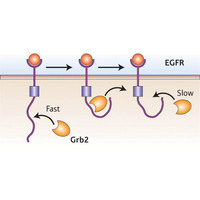Home > Press > Small changes, big impacts
 |
| Figure 1: The initial ‘fast’ association of EGFR with Grb2 is believed to lead to a conformational change in the receptor; when the first Grb2 molecule dissociates, the receptor initially maintains this new ‘slow’ conformation, which markedly reduces the affinity of Grb2 and reduces the rate of subsequent binding interactions. |
Abstract:
Molecular-scale rearrangements influence how receptors transmit their message, adding another layer of complexity to the regulation of cell signaling
Small changes, big impacts
Japan | Posted on January 25th, 2008The pathways by which signals are transmitted within cells are extremely convoluted, involving sequential interactions between large numbers of individual proteins. Modeling these pathways is a daunting enough challenge, but recent studies designed to actively monitor individual protein molecules have hinted at additional levels of complexity.
"Single-molecule studies suggest that proteins [undergo] complex structural and reaction dynamics," explains Yasushi Sako, a biophysics specialist at the Discovery Research Institute in Wako who specializes in biomolecular imaging. "We wanted to investigate the possibility that complex protein dynamics are involved in molecular-level signal processing." Sako and colleagues focused on epidermal growth factor receptor (EGFR), a membrane protein that transmits signals responsible for cell division. Several proteins bind to EGFR following activation, including Grb2, which serves as an ‘adaptor' that enables other signaling proteins to associate with the receptor.
Sako and colleagues took advantage of sophisticated new imaging methods that made it possible for the first time to examine the interaction of Grb2 with full-length, intact EGFR, yielding valuable insights into the kinetics of association between these two proteins1. The group attached individual receptor molecules to a solid support, and then exposed the receptor molecules to different amounts of fluorescently tagged Grb2; by monitoring the appearance and disappearance of fluorescence at individual receptor locations, they were able to quantitatively measure Grb2 binding and release.
Instead of a basic on-off interaction between the two proteins, the interaction data suggested a far more complex picture, where the rate of association with EGFR is strongly dependent on the concentration of Grb2. "This means that the protein EGFR can sense the concentration of its association partner," says Sako. Their findings further suggested the receptor does not constantly maintain a single fixed structure, but instead transitions through multiple structural ‘substates', and that these fluctuations in turn affect the kinetics of subsequent interactions between receptor molecules and Grb2 (Fig. 1).
The resulting model reveals an additional level of fine control over the process of signal transduction at the molecular scale, and Sako suggests that a better understanding of the structural changes involved could be a boon for future bioengineering projects. "If we know the mechanism of the molecular-level signal processing and can design the reaction behavior of proteins at will," he says, "that would be big progress toward realizing sophisticated protein nanomachines."
Reference
1. Morimatsu, M., Takagi, H., Ota, K., Iwamoto, R., Yanagida, T. & Sako, Y. Multiple-state reactions between the epidermal growth factor receptor and Grb2 as observed by using single-molecule analysis. Proceedings of the National Academy of Sciences USA 104, 18013-18018 (2007).
####
About RIKEN
RIKEN is one of Japan’s largest research organisations with institutes and centres in various locations in Japan (see www.riken.jp/engn/r-world/link/index.html). RIKEN’s 3000+ researchers publish several hundred research articles in top scientific and technical journals every year across a broad spectrum of disciplines in physics, chemistry, biology, medicine, earth science and in many areas of technology, and the number of articles is growing year on year.
For more information, please click here
Contacts:
2-1 Hirosawa, Wako, Saitama 351-0198
TEL : +81-(0)48-462-1111(Switchboard Number)
FAX : +81-(0)48-462-4713
Copyright © RIKEN
If you have a comment, please Contact us.Issuers of news releases, not 7th Wave, Inc. or Nanotechnology Now, are solely responsible for the accuracy of the content.
| Related News Press |
News and information
![]() Simulating magnetization in a Heisenberg quantum spin chain April 5th, 2024
Simulating magnetization in a Heisenberg quantum spin chain April 5th, 2024
![]() NRL charters Navy’s quantum inertial navigation path to reduce drift April 5th, 2024
NRL charters Navy’s quantum inertial navigation path to reduce drift April 5th, 2024
![]() Discovery points path to flash-like memory for storing qubits: Rice find could hasten development of nonvolatile quantum memory April 5th, 2024
Discovery points path to flash-like memory for storing qubits: Rice find could hasten development of nonvolatile quantum memory April 5th, 2024
Discoveries
![]() Chemical reactions can scramble quantum information as well as black holes April 5th, 2024
Chemical reactions can scramble quantum information as well as black holes April 5th, 2024
![]() New micromaterial releases nanoparticles that selectively destroy cancer cells April 5th, 2024
New micromaterial releases nanoparticles that selectively destroy cancer cells April 5th, 2024
![]() Utilizing palladium for addressing contact issues of buried oxide thin film transistors April 5th, 2024
Utilizing palladium for addressing contact issues of buried oxide thin film transistors April 5th, 2024
Announcements
![]() NRL charters Navy’s quantum inertial navigation path to reduce drift April 5th, 2024
NRL charters Navy’s quantum inertial navigation path to reduce drift April 5th, 2024
![]() Discovery points path to flash-like memory for storing qubits: Rice find could hasten development of nonvolatile quantum memory April 5th, 2024
Discovery points path to flash-like memory for storing qubits: Rice find could hasten development of nonvolatile quantum memory April 5th, 2024
|
|
||
|
|
||
| The latest news from around the world, FREE | ||
|
|
||
|
|
||
| Premium Products | ||
|
|
||
|
Only the news you want to read!
Learn More |
||
|
|
||
|
Full-service, expert consulting
Learn More |
||
|
|
||








